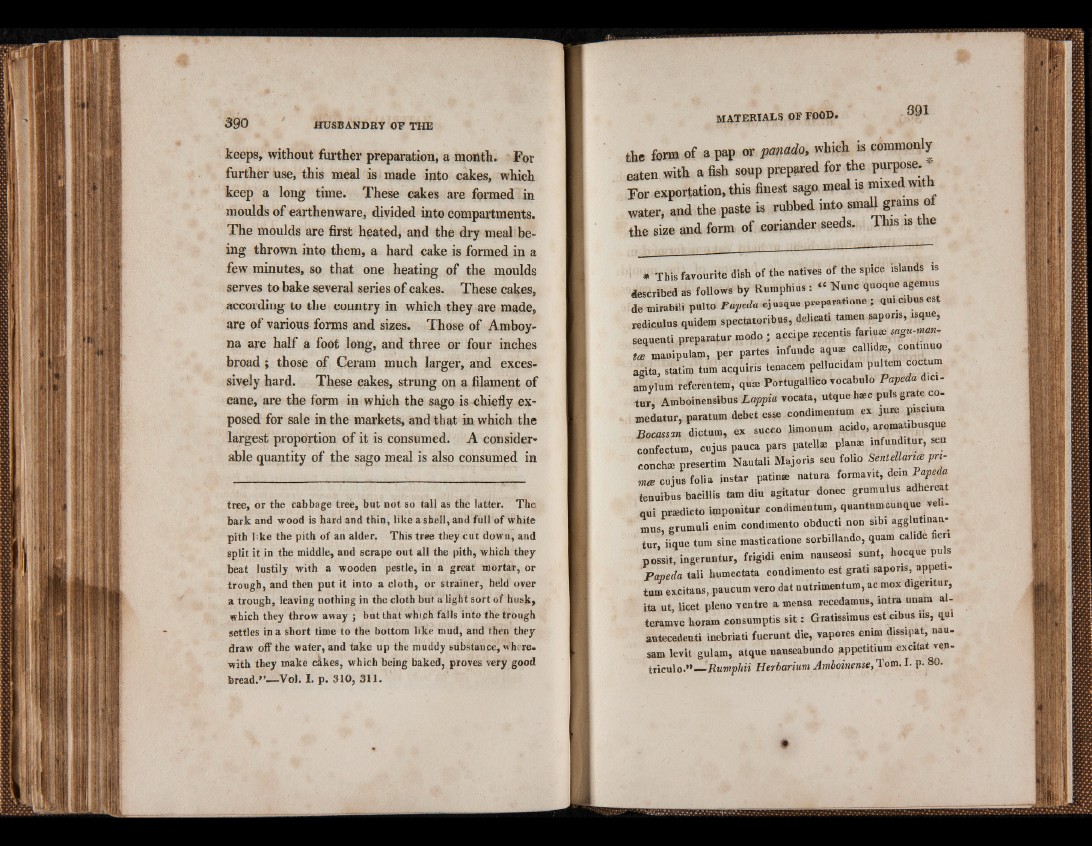
keeps, without further preparation, a month. For
further use, this meal is made into cakes, which
keep a long time. These cakes are formed in
moulds of earthenware, divided into compartments.
The moulds are first heated, and the dry meal being
thrown into them, a hard cake is formed in a
few minutes, so that one heating of the moulds
serves to bake several series of cakes. These cakes,
according to the country in which they are made,
are of various forms and sizes. Those of Amboy-
na are half ,a foot long, and three or four inches
broad; those of Ceram much larger, and excessively
hard. These cakes, strung on a filament of
cane, are the form in which the sago is chiefly exposed
for sale in the markets, and that in which the
largest proportion of it is consumed. A considerable
quantity of the sago meal is also consumed in
tree, or the cabbage tree, but not so tall as the latter. The
bark and wood is hard and thin, like a shell, and full of white
pith bke the pith of an alder. This tree they cut down, and
split it in the middle, and scrape out all the pith, which they
beat lustily with a wooden pestle, in a great mortar, or
trough, and then put it into a cloth, or strainer, held oyer
a trough, leaving nothing in the cloth but a light sort of hus]c,
which they throw away ; but that which falls into the trough
settles in a short time to the bottom like mud, and then they
draw off the water, and take up the muddy substance, Wherewith
they make cakes, which being baked, proves very good
bread.”—Vol. I. p. 310, 311.
the form of a pap or potiado, which is commonly
eaten with a fish sonp prepared for the FWJJfift.
For exportation, this finest sag» meal is mixed mth
water, and the paste is rubbed into small grams of
the size and form of coriander seeds. This is the
1 * This favourite dish of the natives of the spice islands is
described as follows by Rumphius : “ Nunc quoque agemus
de mirabili pulto Papeda ejusque preparatone ; qui cibusest
rediculus quidem spectatoribus, delicati tamen sapons, isqne,
sequent! preparatur modo ; accipe receptis fanuæ sagu-man-
tce manipulara, per partes infunde aquæ call.dæ, continuo
agita, stathn turn acquiris tenacem pellucida«. puUem coctum
amylum referentem, quæ Portugallico vocabulo Papeda A w
tu r, Amboinensibus Lappia vocata, utquehæc puls grate co-
medatur, paratura debet esse condimentum ex jure pisciuia
Bocassm dictum, ex succo limonum acido, aromatibusque
confectum, cujas pauca pars patellae plau* infunditur, sen
conchæ presertim Nautali Majoris seu folio Sentellanoe p n -
ma> cujus folia instar patirne natura formavit, dein Papeda
tenuibus bacillis tam diu agitator donee grumulus adhereat
qui pmdicto imponitur condimentum, quantumeunque veb-
mus, grumuli enim condimento obducti non sibi agglutinan-
tur, iique turn sine masticatione sorbillando, quam calide fieri
possit, ingernntur, frigidi enim nauseosi sunt, hocque pu s
Papeda tali humectata condimento est grati sapons, appe i-
tum excitans, paucum vero dat nutrimentum, ac mox digcntur,
ita ut, licet pleno ventre a mensa recedamus, intra unam al-
teramve horam consumptis sii : Gratissimus est cibus us, qui
anteeedeuti inebriati fuerunt die, vapores enim dissipât, nau-
sam levit gulam, atque nauseabundo appetitium excitât v ^ -
triculo.” —jRuwjj/oï Herbarium Amboinense, Tom. I. p. 80.